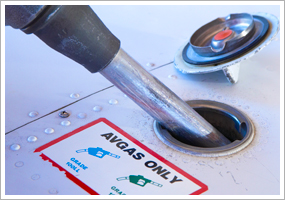| ||||
| | FT News | INSIDE AOPA | TRAINING PRODUCTS | FINAL EXAM | |||
TRAINING TIPs‘Usable’ fuelHow much fuel does your trainer carry when “topped off” for flight? How much is actually available for flight planning? Your fuel system awareness will be closely examined on knowledge and practical tests. Consider this private pilot knowledge test sample question:
The Aircraft Weight and Balance Handbook addresses this subject, presenting a chart for an aircraft with a total fuel capacity of 92 gallons: “The maximum fuel is marked on the diagonal line for fuel in terms of gallons and liters. The maximum is 88 gallons of usable fuel. The total capacity is 92 gallons, but 4 gallons are unusable and have already been included in the empty weight of the aircraft.”
What does your trainer’s pilot’s operating handbook say about usable fuel? A 1980 Cessna 152 holds 26 gallons of fuel, but only 24.5 gallons are usable. Remember: That unusable 1.5 gallons is NOT available for flight planning purposes (or reserves).
Sometimes your load prevents topping off. Some manufacturers provide a way for the pilot to know how much fuel there is in a less-than-full tank, explains Mark Twombly’s “What It Looks Like” column in the September 2009 AOPA Flight Training: “For example, a Piper PA-28-161 Warrior III has one fuel tank in each wing, with each tank having a capacity of 24 gallons usable fuel. That's listed in the Limitations section of the POH. But in the Descriptions and Operation section under Fuel System, it says, ‘Each tank is equipped with a filler neck indicator tab to aid in determining fuel remaining when the tanks are not full. Usable capacity to the bottom of the indicator tab is 17 gallons.’”
Never gamble on fuel’s usability, as this excerpt from a fuel exhaustion accident report involving a Cessna 172 makes clear: “During removal of the airplane from the accident scene, about 3 gallons of fuel was found in the fuel tanks, consistent with the amount of unusable fuel in a Cessna 172E.”
So, what answer did you choose to the knowledge test question above? The correct answer is A. YOUR PARTNER IN TRAININGHave you taken a short break from flying and now you’re getting back into it? Many pilots do it. Some leave for just a month or two while others have been gone for decades. Whether you’re a student pilot or an experienced airman who has been away from the game for awhile, AOPA has resources to help. Visit our subject report on getting back into flying for all you need to know to become current again. There’s even a section that breaks down the major changes in aviation by decade to help you get back up to speed.
Student pilots who join AOPA are three times more likely to complete their flight training. Membership includes unlimited access to aviation information by phone (800/USA-AOPA, weekdays from 8:30 a.m. to 6 p.m. Eastern time) or from AOPA Flight Training Online or AOPA Online. If you’re not already a member, join today and get the pilot’s edge. Login information is available online. FLIGHT TRAINING NEWSFAA modifies sport pilot rulesFlight instructors no longer have to log five hours in make and model of light sport aircraft to provide training, and Part 141 flight schools can now use light sport aircraft, according to new rules the FAA recently finalized. The rules are a result of a process that solicited comments from AOPA and others. Among the many changes to the rules are that pilots in mountainous terrain can fly above 10,000 feet mean sea level so long as they remain at or below 2,000 feet above the ground. Read more >> New instrument rating PTS releasedInstrument students and flight instructors take note: The FAA has released a new version of the Instrument Rating Practical Test Standards by which practical tests will be conducted. Most of the changes were made to conform to other FAA documents, but some operational changes were made. They include standards for LPV, or GPS-based precision-like instrument approaches, and special emphasis on icing and other hazards. The FAA is now conducting checkrides based on these standards, so pilots and instructors should make themselves aware of the changes. Spring could herald knowledge test fee increaseStudent pilots taking the FAA knowledge test after this spring could be hit with an extra $50 fee if testing services’ plan goes forward. Computer Assisted Testing Service Inc. and LaserGrade notified AOPA early this year that they would begin imposing the extra fee on test-takers effective April 1. The testing services said they would use the proceeds of the fee to comply with new requirements from the FAA. Read more >> Michigan Young Eagle completes knowledge testA 16-year-old EAA Young Eagle from Michigan became the first to complete the private pilot knowledge test through Sporty’s online pilot training course that is now offered free to Young Eagles. Tyler Whitney, 16, of Fenwick, first took a Young Eagles flight in June 2008 with pilot Robert Allers of Greenville. EAA and Sporty’s announced in April 2009 a partnership in which Sporty’s provides a free logbook as well as access to online training for the knowledge test to any youngster who participates in the Young Eagles program. Read more >> Piper Aircraft may start school in BruneiPiper Aircraft may soon open a flight school in the small Southeast Asian nation of Brunei Darussalam. Piper’s new owner, Imprimis, is an investment company with ties to the Brunei government, making the small developed country a natural spot for some of Piper’s operations in Southeast Asia. If Piper is able to open a school it will be the first flight school in the nation, according to the Brunei Times. The school would give Piper access to thousands of students each year who leave Southeast Asia to travel to the West for flight training. Operations are expected to begin by the end of the year. School briefs
inside aopaTest your IFR chart knowledgePart of being a competent instrument pilot is knowing what all those symbols in the IFR en route charts mean. But with everything from triangles to T-routes, it can get confusing. The AOPA Air Safety Foundation wants to help make sure you are on top of your game. Take the foundation's safety quiz on IFR en route charts, underwritten by the AOPA Insurance Agency. The quiz tests your knowledge of some common and some not-so-obvious gotchas we all face on the charts. Jeppesen VFR+GPS Webinar gets an encoreAn encore of Jeppesen's Webinar, “Getting to know Jeppesen VFR+GPS charts,” will take place Tuesday, March 2, at 7 p.m. Eastern time. With a different look and feel from the FAA’s sectional charts, Jeppesen’s VFR+GPS aeronautical charts offer an alternative that is meant to dovetail with the use of GPS for navigation. The charts are designed around common VFR flight paths and local operations, and they include features such as GPS waypoints. During the presentation, Jeppesen's Dave McLean will explain the features of and technology behind the charts, and answer questions submitted by Webinar attendees. Register to participate on the AOPA Webinar page. Have you checked your hull value lately?You knew your aircraft hull value when you bought your airplane. What you may not have realized is that as much as 75 percent of your insurance premium is a direct result of the hull value for your airplane. If the value of your aircraft has fallen since you bought it, you could be paying too much for your insurance and possibly encounter a claim issue in determining between a partial loss and a constructive total. If the value has increased, you could find yourself with inadequate coverage when you need it most. Fortunately, AOPA members have an easy way to check the value of their aircraft using AOPA’s online aircraft valuation service, Vref. The service is free to AOPA members. TRAINING PRODUCTSTear-proof sectional chartsDoes your sectional chart look like your dog tried to eat it as a snack? Try Sporty’s Pilot Shop’s laminated tear-proof sectional charts. The charts can be folded, but are rugged enough to be used multiple times. They are also great for drawing course lines or circling important data with a grease pen. Each chart is $15.95.
Note: Products listed have not been evaluated by ePilot editors unless otherwise noted. AOPA assumes no responsibility for products or services listed or for claims or actions by manufacturers or vendors. FINAL EXAMQuestion: What are speed brakes, and what is their purpose?
Answer: Speed brakes are aerodynamic devices usually installed on the top of the wing that disrupt the flow of air over the wing. This disruption allows for high rates of descent without drastically increasing the airspeed, which allows the pilot to keep more power applied to keep the engine warm and reduce the chance of shock-cooling the engine. Speed brakes are most commonly found on large jet or turboprop aircraft, but some high-performance piston aircraft have them as well.
Got a question for our technical services staff? E-mail [email protected] or call the Pilot Information Center, 800/872-2672. Don’t forget the online archive of “Final Exam” questions and answers, searchable by keyword or topic. Picture Perfect
AVIATION EVENTS & WEATHER To submit an event or to search all events in the calendar, visit AOPA Online. For airport details, including FBO fuel prices, see AOPA’s Airport Directory Online. Flight Instructor Refresher ClinicsThe next AOPA Air Safety Foundation Flight Instructor Refresher Clinics are scheduled in Melbourne, Fla., Louisville, Ky., and Nashua, N.H., Feb. 20 and 21; Baton Rouge, La., Oklahoma City, Okla., Dallas, Texas, and Ashburn, Va., Feb. 27 and 28; Orlando, Fla., March 6 and 7; San Mateo, Calif., and Baltimore, Md., March 13 and 14; Ontario, Calif., March 20 and 21. For a complete schedule, see AOPA Online.
Can’t make it in person? Sign up for the CFI Refresher Online. AOPA Air Safety Foundation Safety SeminarsAOPA Air Safety Foundation Safety Seminars are scheduled in Huntsville, Ala., Feb. 16; Decatur, Ga., Feb. 17; Greenville, S.C., Feb. 18; Puyallup, Wash., Feb. 20 and 21; Northglenn, Colo., Feb. 23; Colorado Springs, Colo., Feb. 24. Topics vary—for details and a complete schedule, see AOPA Online. | Got news? Contact ePilot. Having difficulty using this service? Visit the ePilot Frequently Asked Questions now at AOPA Online or write to [email protected]. |
| Member Tools : Send feedback | Update member profile | Change email address | Unsubscribe | ePilot Archive Editorial Team: ePilot Flight Training Editor : Ian Twombly | ePilot Editor: Sarah Brown | Contributor: Alton Marsh |

 Which items are included in the empty weight of an aircraft?
Which items are included in the empty weight of an aircraft?


